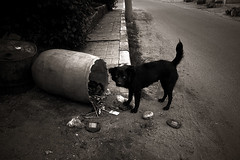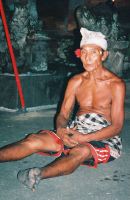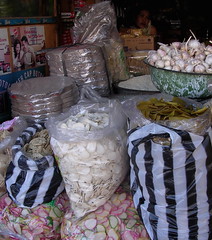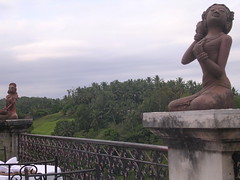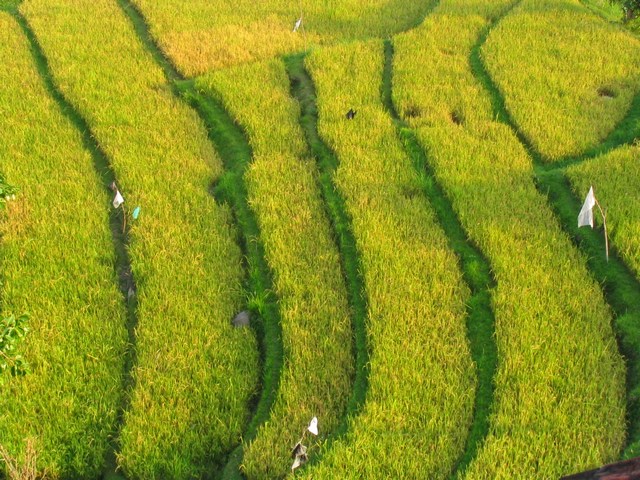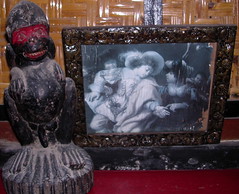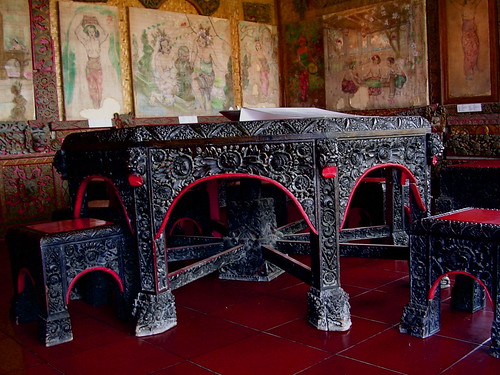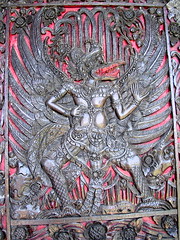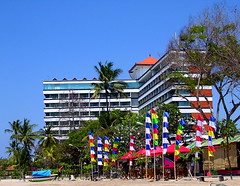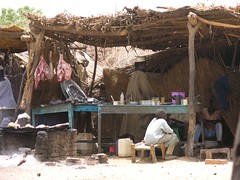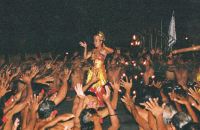
Two things about this post. It's important to remember that "c" in Indonesian is pronounced "ch". "Cak", as Racki renders it is in fact, I think, a cross between "chuck" and "chack". Second, the photo is from
this site; I stole it from Andy and Susanne Carvin's honeymoon. Their snaps are well worth having a
look at. I think they went to exactly the same performance I did, but a couple of years earlier.
After eating at Indus, we just made it to the kecak dance down Jl Hanoman. The whole thing was a mystery I am yet to unravel, particularly the bit where a hessian sack full of coconut husks was dumped on the stage, set alight with some kind of spirits, reduced to embers, and then kicked by a barefooted old man who then walked across the coals, all the while riding a broomstick with a carved wooden horse's head, and coconut leaf mane and tail.
That part, I think, was the so-called "fire dance", an even greater mystery, and one which left the crowd gawping and gasping loudly with shock. When it was over, a younger man came and announced the fact. The stunned crowd sat starting at the old man, sitting on the ground, his legs straight out in front of him, his charred soles facing the crowd, the crowd facing them. He sat there as if in a trance. I had to go and I do not know how the crowd and the man resolved their situation.
I do know that the kecak dance, the monkey dance, is a secular dance, choreographed by Walter Spies and Katherine Mershon in 1930 for a German movie, "Island of the Demons". Mind you, that is an exaggeration, for according to Christian Racki's
The Sacred Dances of Bali:
"The Kecak comes from the Sanghyan in which a chorus of men alternates with a group of women to help dancers enter in trance. In the 1930s Walter Spies, a German painter and anthropologist, made a proposal to dancers of the village of Bedalu to enlarge this chorus which in the beginning comprised only a dozen men, and to give it its own life. Spies collaborated with a Balinese, Bak Limbak (who had created the first version of the Kecak), to have the chorus accompany one episode of the Ramayana. As time went on, the spectacle incorporated other episodes of this story as well as other mythical stories."
It is entertaining; anyone who has seen "Baraka", a Koyanisqaatsi / Powaqqatsi style movie without words, will be amazed to learn that the extraordinary sequence of black and white checked saronged men chanting and moving in unison is a near-nightly tourist ritual. It is not easy to describe. I will not try to better Racki's description:
"The chorus of young men flood the stage, shouting the syllable 'cak', all the while walking with legs and elbows bent, and fingers extending into a trembling fan of energy. They sit in one concentric circle around the fire and after repeated chants and synchronised gestures, they bow to the priest who blesses them with holy water. Once the priest has left, the chorus once more bounds in to the 'cak], varying in fast and slow rhythmic sequences -- punctuated by the ]cak cak pour chir'. This chorus is divided in several sub-groups which 'layer' various 'cak', one upon another. A tumultuous global resonance is created by these patterns. All changes in movement and singing are led by a chorus member. Even though rhythmical structures of 'cak' are different, the gestures are uniform until the dramatic action begins. When the voice of the juru tendak emerges from the group to narrate the unfolding story, the dancers arrive to perform the Ramayana (or another legend). Afterwords, the chorus surrounds them, dividing into several smaller groups with distinctive gestures that docorate the dance. After the drama has ended, the kecak chorus disappears just as it came."
Something about the whole thing was wrong. There was no explanation other than a piece of paper. The considerable audience sat there, each having paid A$7, a substantial sum comparatively, and I can only imagine they were as perplexed as I. Murni of Ubud warns:
"It is almost impossible for the new spectator to follow the plot. Boys dance girls' parts, girls dance boys' parts. You cannot tell which are which; both wear heavy make-up. the same person may dance several roles, and scenes change with the barest of announcements. It's best just to sit back and enjoy the extreme beauty of the movements, the expressions, and the dazzling costumes."
Racki says, with a frankness more anthropologists might employ:
"As they are indifferent to content, Balinese are much more casual spectators than Westerners, who go to a dance with the intention of learning something [do we?]. The Balinese talk and sleep, paying attention only when it best suits them -- when the clowns come out, if they are children, or when the dancers step on stage, if they are the dancers' mothers."
Earlier, he had said:
"the youth ... attend the show as much to look for a girl or a boy friend as to attend the performance itself. Dance is thus part of the mating game. Girls are the best spectators; they stand in groups of two or three, holding each other by the hand or waist, attentive to the minutest details of the dancer's hands. Boys pretend to come for the show, but they are restively on the chase, prowling at a short distance in tehir own groups of two or three. Every few minutes, they approach, supposedly to get closer to the stage, but actually to get nearer to the girls; a quick pinch, a few words and the message gets across. Dates are thus made and love stories begin."
Bali




